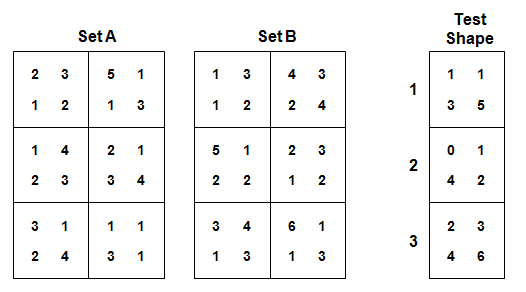UKCAT Advanced Abstract Test Patterns
Often UKCAT abstract reasoning tests contain questions that test takers find hard to figure out. Such questions may not only present with patterns that include shapes and symbols with wide range of different twists but also present with distracting items that are build in to test your ability to filter out critical information to make reasonable conclusions. To answer these questions correctly you will have to maintain sharp focus and take strategic approach to find out rules that apply to pattern. The below text attempts to demonstrate how to go about answering these types of questions in UKCAT abstract reasoning tests. Good luck with your preparation.
For the following let’s look at some complex pattern that you may be presented in UKCAT abstract reasoning test. If you have taken this test in past then you know that your task is to find whether the test shapes belong to set A, set B or neither set based on the properties of sets. For the following consider the below example extracted from UKCAT abstract reasoning test and see whether you can get the question right.
 |
Determine whether the test shapes belong to set A, set B or neither.
In the above question a great deal of test takers could spend large proportion of time searching for pattern. Perhaps, some could be looking at the number or position of particular digits in each box or could search for other rules. Note that it is important to focus your efforts on most likely ways to reveal the pattern without spending much of your time. In UKCAT abstract reasoning test be careful not to spend most of your time trying to work out questions you find difficult. Remember, you need to know when the time to move on to the next question is. As a general rule, if you don’t find the pattern within 30 to 40 seconds you may not find it with more time so move on.
Notice that if you look at the boxes carefully you would find that when you add together the numbers in each box the sum would amount to even number in set A and odd number in set B. Hence, for the above pattern you may conclude that the test shape 1 belongs to set A because the sum of its digits gives us even number whereas the test shape 2 and 3 gives us the odd number after summing up its digits and hence the correct answer is that the test shapes two and three belong to set B. If you want to review further questions then see our tutorial on UKCAT abstract test patterns which will help you become familiar with range of patterns often incorporated into these tests.
At last, the complexity of questions in UKCAT abstract reasoning tests may come in variety of forms such as patterns presented with unusual shapes, symbols or item arrangements. However, most of the abstract reasoning test questions tend to include relatively simple patterns on which you can achieve good score.

